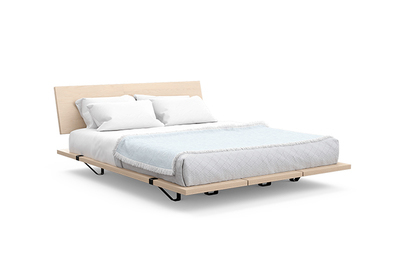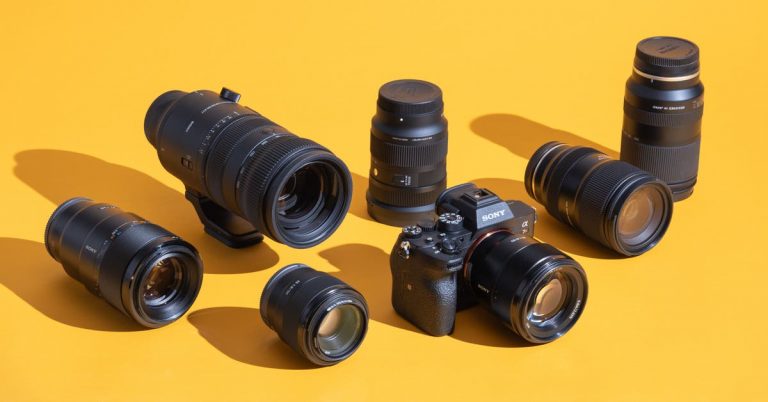The 9 Best Bed Frames of 2025

Top pick
Best for: Anyone who wants a modern, low-profile frame that doesn’t sacrifice long-term flexibility (you can add width, a headboard, and underbed storage at any time) or convenience (it disassembles into components for easy moving days)—and who prefers or doesn’t mind a lower bed.
Why it’s great: We think Floyd’s The Bed Frame comes close to the ideal among flexible furniture. Its modular design, consisting of just two, three, or four panels (depending on the frame size you pick) that slot into powder-coated steel supports, is impressively simple, and there are few things that can snag or break. Those supports, each made from a single piece of steel to reduce waste, keep the panels separated, ensuring necessary airflow, and are secured in place with two adjustable nylon straps (tucked well out of view), allowing the bed to bear up to 600 pounds.
The panels, each about two feet wide and weighing just over 40 pounds, are composed of engineered birch with a “honeycomb” structure, a design that Floyd says provides strength without density, keeping the components lightweight for their size. The assembled look reminds us of a floating raft or platform, understated in profile but with an elegant horizontal gesture, as well as a welcome warmth from the wood finish.
Our tester has owned this bed frame (birch veneer panels, white supports) since 2017, and the frame has seen two apartments, two cities, and vastly different climates, with no visible wear or damage despite a cross-country stint in a storage container. For frequent movers, or those who live in walk-ups, it’s a bonus that the Floyd bed frame easily disassembles and reassembles without a single tool and stores compactly.
The Floyd arrives in two efficiently packed cardboard boxes, one with the panels and the other with the steel supports, along with adhesive cork floor protectors; you access the instructions online (video). Assembly is conceptually simple and relatively easy—like the Thuma, the Floyd does not require any tools to assemble, not even a hex key. It does call for some coordination to slot the first panel into its supports so that it will stand on its own, but since you can nudge the steel supports along the length of the panel to align them afterward, it’s a relatively forgiving task, even when done alone.
Due to the bed’s low profile, we found it a little awkward to loop them around the structural brackets, which you must do in order to tighten them properly. The ratchets you use to fully tighten the straps—which is necessary to hold the structure so that the bed can bear weight—can be irritating, especially if you’re unfamiliar with such mechanisms, but Floyd’s materials give clear instructions.
All that said, our tester assembled the queen-size bed solo the first time, although they found the task infinitely easier to do with a partner. We recommend enlisting an extra pair of hands to help.
Perhaps the biggest reason to consider a Floyd is that it’s the bed frame you won’t outgrow, since its modular design allows it to adapt to your needs. An expansion kit (an extra panel plus steel supports) costs between $340 and $460—significantly cheaper than buying another bed of comparable quality—and cuts down on furniture waste. You can also add a headboard for $390 to $490, depending on whether you have a full/queen or a king, and underbed storage.
Flaws but not dealbreakers: When we first published this guide, we listed this frame in the Competition section due to concerns that its 22-inch-wide panels, even with the gaps between, would not allow enough moisture to evaporate. However, our tester has been sleeping on the same Floyd bed frame for almost six years and is sensitive to indoor allergens, including mold and mildew, and has not observed any moisture concerns even in a climate with hot and sticky summers. We no longer believe that the Floyd’s design poses a health risk, but you may still want to think twice if you live in a perennially damp climate and do not sleep in a climate-controlled environment (since heating and air conditioning both dry out the air).
Keep in mind that the full/queen size and the king size (which accommodates both king and California king mattresses) are designed to fit both mattress sizes, so if you have the smaller mattress for the frame size, more of the platform will be exposed, creating a kind of ledge. This changes the experience of using the bed, including reaching bedside items and sitting on the edge of the mattress, potentially impacting accessibility. California king owners should also note that the mattress will take up too much room for the headboard add-on to fit. Last, the Floyd is the lowest bed among our picks, with the top of the platform rising only 7½ inches from the floor—a full 4 inches shorter than the Akron Street Mysa Bed—which may help or hamper accessibility and can make cleaning under the bed cumbersome.
In 2022, Floyd reduced its 10-year warranty to just one year, which gives us pause. We’ll be keeping an eye on quality and any other changes and update our recommendation if needed.
| Materials | birch plywood with birch veneer, oak veneer, or walnut veneer; powder-coated steel; nylon straps with plastic and metal ratchets |
| Finishes/colors | birch or American FSC–certified walnut veneer, with black or white powder-coated hardware |
| Sizes available | twin, full/queen, king |
| Warranty/returns | 1-year warranty from date of purchase; free returns within 30 days in original packaging |
| Shipping | 12% of order value or up to $399 max, ships only within the contiguous United States |







